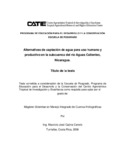| dc.contributor.advisor | Faustino, J. | |
| dc.contributor.author | Cajina Canelo, Mauricio J. | |
| dc.contributor.other | CATIE - Centro Agronómico Tropical de Investigación y Enseñanza | |
| dc.date.accessioned | 2014-10-20T04:02:49Z | |
| dc.date.available | 2014-10-20T04:02:49Z | |
| dc.date.issued | 2006 | es_ES |
| dc.identifier | 369742 | es_ES |
| dc.identifier.uri | https://repositorio.catie.ac.cr/handle/11554/4426 | |
| dc.description | Tesis (Mag.) -- CATIE, 2006 | es_ES |
| dc.description.abstract | El estudio se realizó en la subcuenca del río Aguas Calientes, Nicaragua con el objetivo de determinar en forma participativa tecnologías alternativas de captación de agua superficial apropiadas a las características biofísicas de la subcuenca y a las condiciones socioeconómicas de las comunidades, que permitan aprovechar de manera eficiente y sostenible el recurso hídrico, debido a que el principal problema es escasez de agua como eje del círculo vicioso de pobreza, vulnerabilidad e inseguridad alimentaria. Los resultados orientan que en la subcuenca existe un déficit de agua en los cultivos básicos y consumo humano, sin embargo se identificaron ochenta áreas potenciales de captación de agua durante el periodo lluvioso, para uso productivo. En contribución de proponer tecnologías se identificaron y seleccionaron diecisiete tecnologías, se priorizaron diez. Se construyeron seis obras demostrativas. This study was carried out in the Aguas Calientes river subwatershed, Nicaragua, with the objective to determine in a participative manner, superficial water capture alternative technologies which are appropriate for the biophysical characteristics of the subwatershed and the social-economic conditions of the communities. These technologies allow the hydric resources to be used in an efficient and sustainable manner, since the principal problem is water scarcity as part of the vicious cycle of poverty, vulnerability and uncertain food supply. The results suggest that there is a water deficit for basic crops and human consumption however, eighty potential water capture areas were identified during the rainy season. As far as contributing to proposed technologies, seventeen technologies were identified and selected, and from these, ten were prioritized. | es_ES |
| dc.language.iso | es | es_ES |
| dc.publisher | CATIE, Turrialba (Costa Rica) | es_ES |
| dc.relation.ispartof | Maestría en Manejo y Gestión en Cuencas Hidrográficas | |
| dc.rights | info:eu-repo/semantics/openAccess | es_ES |
| dc.subject | NICARAGUA | |
| dc.subject | AGUA POTABLE | |
| dc.subject | AGUA DE RIEGO | |
| dc.subject | USO DEL AGUA | |
| dc.subject | ABASTECIMIENTO DE AGUA | |
| dc.subject | INGENIERÍA HIDRÁULICA | |
| dc.subject | CAPTACIÓN DE AGUAS | |
| dc.subject | SEQUÍA | |
| dc.subject | CONSERVACIÓN DE LOS RECURSOS | |
| dc.subject | ENTORNO SOCIOECONÓMICO | |
| dc.subject.other | Sede Central | |
| dc.title | Alternativas de captación de agua para uso humano y productivo en la subcuenca del Río Aguas Calientes, Nicaragua | es_ES |
| dc.title.alternative | Alternatives for capturing drinking and productive water in the Aguas Calientes river sub-watershed, Nicaragua | es_ES |
| dc.type | Tesis de maestría | es_ES |


